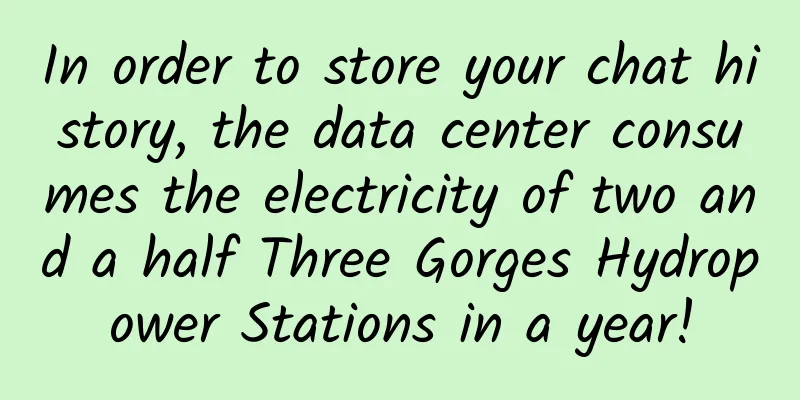In order to store your chat history, the data center consumes the electricity of two and a half Three Gorges Hydropower Stations in a year!

|
Audit expert: Ji Hongzeng PhD candidate in Power Engineering and Engineering Thermophysics, Beijing Institute of Technology Some time ago, an incident in which many netizens were unable to watch videos due to a server failure became a hot topic, and this incident caused people to worry about data security. Data is not unfamiliar to us. What usually takes up the most storage space in your mobile phone? Of course, it is all kinds of data, whether it is the data generated by browsing various apps every day, browsing massive pictures and videos, or even chatting with friends... These are undoubtedly data. Do you know how much electricity is consumed by storing our daily chat records? In this information society, we cannot live without all kinds of data. In order to facilitate our production and life, a large number of data centers are hidden around us. According to statistics, the electricity consumption of China's data centers accounts for about 2% of China's total social electricity consumption, and it consumes the equivalent of the annual power generation of two and a half Three Gorges Hydropower Stations in one year. What exactly is the role of a data center? A data center is a dedicated network of hardware devices, also known as an information center. It is used to transmit, speed up, display, calculate, and store data information on the Internet infrastructure. Source: Baidu Encyclopedia The emergence of information centers enables people to enter the unreal virtual realm from the real world. It gradually integrates various types of network connections into the infrastructure of today's society, which has an impact on many industries, like a double-edged sword, with both good and bad effects. Why does it consume so much power? As the physical cornerstone of the network, data centers have always been a relatively unknown topic to the public. The construction of data centers requires an environment, hardware equipment, basic software, and an application support platform. The hardware equipment mainly includes network equipment, network security servers, storage equipment, disaster recovery, etc. In addition to traditional data centers, there are also super-large data centers around the world. They usually have tens of thousands to hundreds of thousands of servers, occupy a large area, and consume a lot of power. Source: Tianji.com Current research shows that most of the world's energy consumption still comes from large data centers. Data centers are huge power consumers. According to the White Paper on the Current Energy Consumption of Data Centers in China, data center power consumption reached 100 billion kWh in 2015, accounting for more than 1.5% of the country's total electricity consumption. In the United States, its total electricity consumption reached an astonishing 91 billion kWh in 2013. According to surveys, the total annual electricity consumption of Chinese data centers in 2020 has reached 138 billion kWh, and electricity costs alone account for 60%-70% of the total operating costs of the entire data center, of which air conditioning energy consumption accounts for 40%. Source: pixabay Just like our personal computers use fans to dissipate the heat of the CPU, the cooling measures for countless servers gathered together cannot be ignored. Taking my country's computer room as an example, as of the end of 2019, the number of equipment racks in my country's data centers was 2.658 million, a year-on-year increase of 28.7%, and this is a simple statistics excluding data centers under construction. The power distribution of China's computer rooms accounts for most of the national power distribution, and IT equipment and refrigeration and temperature control usually account for 85% of the total energy consumption of data centers. Among IT equipment, server systems and storage systems consume about 50% and 35% of electricity respectively. From the above data, it can be seen that refrigeration and temperature control and computer room operation are key parts that affect the energy consumption of data centers. In addition, there is energy consumption from other electrical appliances in the computer room. The energy consumption of lighting and fire protection is also one of the energy killers of the data center. How can we reduce the power consumption of data centers? As the new generation of data centers begins to speed up, the density of servers in the computer room gradually increases, and reducing energy consumption and heat dissipation has become a top priority. Data center energy conservation should be carried out from many aspects: building location and environment, airflow and air conditioning system, green energy conservation, IT equipment, etc. As early as 2018, Microsoft Center simulated the construction of an intelligent data center on the seabed, allowing it to operate in a self-sufficient manner hundreds of feet under the sea, and also solved a huge problem that has plagued the company's development: high air conditioning costs. Such data centers have given great inspiration to major Internet giants to use natural resources to save energy and save costs. For example, Tencent's Gui'an Qixing Data Center is built on the top of two mountains, storing more than 300,000 disaster recovery servers and having a working area of more than four standard football fields. Tencent stated that a data center built in such an environment can not only avoid the influence of outside air on the equipment, but also use the special structure of the cave to form a huge natural air conditioner to dissipate heat for the center. Source: pixabay In addition to the green energy saving of the cooling system, which consumes the most energy, there are several other ways to save energy in data centers: 1. Server Virtualization Virtualization technology allows one physical server to manage multiple virtual hosts, allows multiple servers to share computing resources, and adjusts server loads to make the best use of resources, reducing carbon dioxide emissions, reducing heat production, making business greener, and improving management and operational efficiency. 2. Use modern cooling methods The HVAC system is usually one of the main power systems in the data center, but the air conditioning system can only operate efficiently in a small area. In large data centers, it is not optimal and efficient. Replacing traditional equipment with more modern and efficient cooling components can save a lot of electricity. 3. Reorganize the information center Reorganizing the physical location of the information center servers, such as configuring cooling and heat exchange channels, can better reduce the load on its system. Source: pixabay 4. Transformer upgrade The AC power supply of the information center requires the use of transformers, which also consume a lot of energy. By modernizing it, the power consumption can be reduced. 5. Upgrade server chips to low-power products 6. Conduct software screening There is no point in running unnecessary servers, so by using software to screen the running servers, unnecessary operations can be reduced, thereby reducing energy consumption. 7. Increase cooling temperature Increasing the cooling temperature within the recommended range can reduce energy consumption. |
>>: Are you one of the people at high risk of cancer?
Recommend
520 Valentine's Day topic marketing!
Long time no see, everyone. In this episode of 5 ...
Case analysis: Promotion of the "Charge and Get Benefits" activity at Station B
As a post-90s who is about to enter his 30s, I st...
How to promote Xiaohongshu
With the continuous development of the Internet, ...
Does Evergrande really want to make cars? Not a single car has been produced, the company has suffered a loss of 4.8 billion yuan in half a year, and its market value has dropped by 80%.
In 2020, Evergrande Group officially announced it...
How to price your product? Here are 4 ways
Price is an important means of competition. Prici...
What is the specific situation of the 78 new confirmed cases in 31 provinces, autonomous regions and municipalities? Which region has the most new cases? Detailed data attached!
After five consecutive days of zero reports, Hube...
When operating mobile game activities, there are 7 minefields that you must avoid!
An unreasonable operation plan and poorly impleme...
NetQin's Q1 net income increased by 11.8% year-on-year, and its entertainment business has begun to show results
In the early hours of this morning, NetQin offici...
Can Pechoin’s 0.008% conversion rate wake you up from your dream of swiping the screen?
Recently, Pechoin ’s amazing advertisement was al...
This mountaintop observatory is painting the largest 3D picture of the universe
Author | Wang Qing Review | Ding Yi, Zhao Jingyua...
Analysis of "9377 Games" advertising strategy and marketing effectiveness
Today, let’s take a look at a classic promotion c...
Why bother looking for a remote control? Experience with Orvibo Allone smart remote control
With so many things, it is hard to find what you n...
Gaining weight every holiday season? Take these 10 tips to keep from gaining weight!
The Double Happiness Festival has just passed, ha...
Google apps now fully support dark mode on Android and iOS
Although Google introduced dark mode for its Andr...









